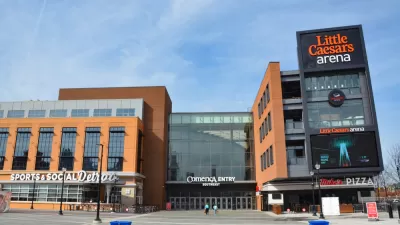One writer takes issue with the city of Detroit's decision to subsidize a $450 million arena plan for the Detroit Red Wings. The Ilitch family, owners of the Detroit Tigers and the Detroit Red Wings, are worth $3.6 billion.
Bill Bradley reports: "the Detroit Red Wings unveiled plans for their brand new publicly subsidized $450 million arena development. The arena, which promises to include $200 million additional investments in mixed-used development, will break ground in September."
"The arena itself is estimated at $450 million, of which the city is paying $262 million—by way of tax increment financing (TIF)—for construction costs. That's 58 percent, not including any cost overruns. The entire project, including the mysterious promise of ancillary investment within five years of the first puck drop, is pegged at $650 million, with $284.5 million of that coming from the TIF."
So with the city's subsidies, not to mention the $1 land transfer deal that enabled the development, one might expect Detroit to have made a better deal on the future arena. However, the project has no local hiring requirements. And there's the money the city will be losing once the team moves out of its old digs: " Under Olympia's current deal with the city for Joe Louis, where the Wings have played since 1979, the city receives roughly $7 million annually in revenue from suite sales (7 percent), food and beverage concessions (10 percent), souvenir sales (5 percent), and ticket proceeds (10 percent). But under the new arena deal, they won't have to share any of the revenues with the city. And Olympia will get all the fees from naming rights, which can rack up millions annually."
FULL STORY: Red Wings Generously Agree To Accept Huge Sums Of Money From Public

Planetizen Federal Action Tracker
A weekly monitor of how Trump’s orders and actions are impacting planners and planning in America.

Congressman Proposes Bill to Rename DC Metro “Trump Train”
The Make Autorail Great Again Act would withhold federal funding to the system until the Washington Metropolitan Area Transit Authority (WMATA), rebrands as the Washington Metropolitan Authority for Greater Access (WMAGA).

The Simple Legislative Tool Transforming Vacant Downtowns
In California, Michigan and Georgia, an easy win is bringing dollars — and delight — back to city centers.

The States Losing Rural Delivery Rooms at an Alarming Pace
In some states, as few as 9% of rural hospitals still deliver babies. As a result, rising pre-term births, no adequate pre-term care and "harrowing" close calls are a growing reality.

The Small South Asian Republic Going all in on EVs
Thanks to one simple policy change less than five years ago, 65% of new cars in this Himalayan country are now electric.

DC Backpedals on Bike Lane Protection, Swaps Barriers for Paint
Citing aesthetic concerns, the city is removing the concrete barriers and flexposts that once separated Arizona Avenue cyclists from motor vehicles.
Urban Design for Planners 1: Software Tools
This six-course series explores essential urban design concepts using open source software and equips planners with the tools they need to participate fully in the urban design process.
Planning for Universal Design
Learn the tools for implementing Universal Design in planning regulations.
Smith Gee Studio
City of Charlotte
City of Camden Redevelopment Agency
City of Astoria
Transportation Research & Education Center (TREC) at Portland State University
US High Speed Rail Association
City of Camden Redevelopment Agency
Municipality of Princeton (NJ)



























